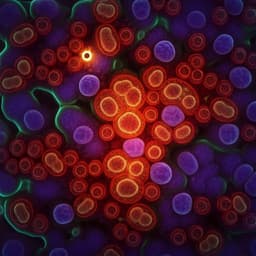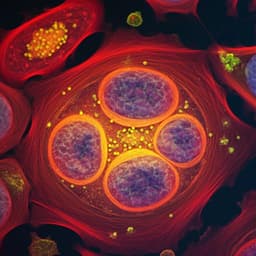Introduction
Photothermal microscopy, a highly sensitive label-free imaging technique, traditionally uses lock-in amplifiers to detect photothermal signals by modulating the excitation beam and demodulating the probe beam. While convenient, this method doesn't fully reveal the richness of thermal dynamics. The current study addresses this limitation by developing a novel photothermal dynamic imaging (PDI) system. This system uses MHz digitization and match filtering at harmonics of the modulation frequency to capture the transient thermal response to single IR pulse excitation. This approach not only enhances the speed and sensitivity of photothermal microscopy but also provides crucial thermal dynamic information previously inaccessible. The ability to resolve nanosecond-scale thermal dynamics opens up new possibilities for studying various biological processes and material properties, particularly in environments where complex thermal responses occur, such as inside living cells. Understanding the thermal properties of different cellular components becomes essential for accurately interpreting photothermal signals and overcoming the limitations of traditional lock-in based methods which often struggle to differentiate between signals from target molecules and the surrounding medium.
Literature Review
Photothermal microscopy has emerged as a powerful tool for label-free imaging with high sensitivity. Conventional methods employ modulated excitation and heterodyne detection with lock-in amplifiers, achieving high sensitivity by reducing background noise. This has enabled the imaging of single nanoparticles and even single molecules. Mid-infrared photothermal (MIP) microscopy, using a mid-IR pump source and visible probe, provides chemically specific information from the transient thermal field. However, existing methods typically focus on steady-state measurements and do not fully capture the wealth of information present in the transient thermal dynamics. Lock-in-based photothermal heterodyne imaging (PHI) can reveal thermal diffusivity through phase detection, but it has limitations in temporal resolution and dynamic range. Time-gated approaches offer temporal resolution, but they require tedious repetitive measurements, making them slow and unsuitable for non-repetitive transient processes. This paper aims to overcome these limitations by introducing a new approach that can capture the full temporal dynamics of the photothermal process.
Methodology
The researchers developed a mid-infrared photothermal dynamic imaging (PDI) system capable of nanosecond-scale temporal resolution and a bandwidth exceeding 25 MHz. A pulsed mid-IR pump beam (quantum cascade laser) and a counter-propagated continuous-wave visible probe beam are focused onto the sample. Backscattered and forward-scattered probe photons are collected by photodiodes connected to a wideband voltage amplifier. The amplified signal, along with the IR pulse monitored by an MCT detector and sample position information, is digitized at 50 million samples per second. Digital signal processing, including match filtering with a comb-like passband in the frequency domain, is used to enhance the signal-to-noise ratio (SNR). The match filtering procedure involves processing acquired data segments in the frequency domain. A comb-like passband is applied, with individual windows centered at the harmonic frequencies of the IR modulation frequency. This effectively rejects noise outside these frequency bands. The inverse Fourier transform then yields the filtered photothermal dynamic signal in the temporal domain. The system's temporal resolution is ultimately limited by the photodiode response time (a few nanoseconds). PMMA particles, E. coli bacteria, and U87 brain cancer cells were used as samples. Photothermal spectra were acquired by varying the mid-IR wavelength and normalizing the intensity at t = 300 ns by the integrated IR pulse energy and focal spot size. Thermal decay constants were obtained by fitting exponential decay functions to the cooling phase of the photothermal signals. Advanced methods, like maximum likelihood estimation and maximum entropy methods, could also be applied. Finite element method (FEM) was used to independently calculate heat transfer parameters for validation.
Key Findings
The PDI system demonstrated a significant improvement in SNR (more than four-fold) compared to lock-in based PHI, enabling high-throughput imaging. The nanosecond temporal resolution allowed for detailed analysis of the heating and cooling phases of the photothermal response, including the direct measurement of the energy flux. The thermal decay constants of PMMA particles were measured and validated using FEM, showing dependence on particle size. High-speed PDI of E. coli bacteria enabled the imaging of carbohydrate metabolism at the single-cell level, with an imaging speed 600 times faster than lock-in based MIP. Isotope-labeled glucose experiments demonstrated the ability to detect metabolic changes based on spectral shifts. In U87 cancer cells, PDI revealed distinct thermal responses for different organelles (lipid droplets, nucleus, cytoplasm), enabling the separation of biomolecular signals from the water background based on their distinct decay times. The analysis of thermal dynamics revealed that some signals attributed to lipids in conventional MIP imaging are actually due to water background effects. By analyzing the high-order harmonics of the photothermal signal, PDI successfully detected extremely weak signals from small lipid droplets obscured by water background in traditional lock-in based methods. The temporal resolution is ultimately limited by the photodetector response, approximately a few nanoseconds.
Discussion
The PDI system significantly advances photothermal microscopy by providing both chemically specific information (via mid-IR absorption) and physically specific information (via nanosecond-scale thermal dynamics) at submicron spatial resolution. The superior SNR and imaging speed of PDI are attributed to the use of MHz digitization and match filtering, which allows for the detection of all harmonic components of the photothermal signal. This contrasts with traditional lock-in methods that primarily detect the fundamental frequency component, losing information and sensitivity, especially for low-duty cycle signals. The ability to separate water background from biomolecular signals based on thermal dynamics is a key advantage of PDI, improving the accuracy and interpretability of the imaging results. The findings regarding distinct thermal responses of different organelles within a cell provide new insights into cellular structure and function. The high throughput capability of PDI makes it well-suited for high-content screening and metabolic analyses.
Conclusion
The development of the nanosecond-resolution photothermal dynamic imaging system represents a significant advancement in photothermal microscopy. The improved SNR, speed, and ability to resolve complex thermal dynamics enable more accurate and detailed studies of biological and material systems. Future work could explore the application of PDI to other spectral regions and investigate the potential for quantitative measurements of thermal properties at the nanoscale. Further development could also incorporate advanced signal processing techniques to extract even more detailed information from the complex temporal dynamics.
Limitations
While the PDI system provides high temporal resolution, the spatial resolution is ultimately limited by the diffraction limit of the visible light used for probe detection. The accuracy of the quantitative temperature measurements is dependent on the accuracy of the models used to relate the photothermal signal to the temperature. The use of deuterated water in cellular experiments might affect the physiological state of the cells. The current system’s relatively high cost might limit widespread adoption. Although advanced methods for decay constant extraction exist, only exponential fitting is employed in the current study.
Related Publications
Explore these studies to deepen your understanding of the subject.







